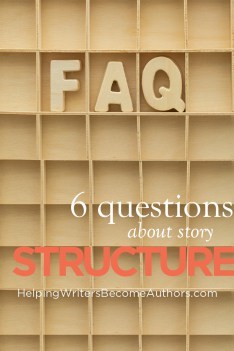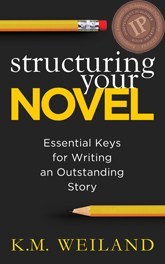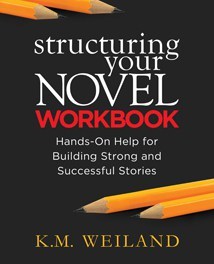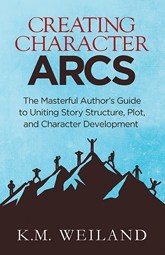Story Structure Q&A: 6 Outstanding Questions About Structure
 Being a good writer is all about being a good learner—having a wide-open mind that’s always looking for the next question. I think you guys must all be good writers, because you know how to ask some good questions! Today, I want to share a story structure Q&A, featuring six thought-provoking emails I’ve received.
Being a good writer is all about being a good learner—having a wide-open mind that’s always looking for the next question. I think you guys must all be good writers, because you know how to ask some good questions! Today, I want to share a story structure Q&A, featuring six thought-provoking emails I’ve received.

Story structure exists as an elegant system for interpreting and making accessible the complex abstractions of story theory. Basically, the principles of story structure are simply the recognition of the patterns that emerge when we look at the larger canon of storytelling throughout the centuries.
Many writers teach different approaches to story structure, but they all boil down to essentially the same thing. Structure, as I teach it, breaks story down into eight equal parts, spread across three acts. These parts are punctuated by nine major moments, which optimally occur equidistant from one another:
Hook: 1%
Inciting Event: 12%
First Plot Point: 25%
First Pinch Point: 37%
Second Plot Point or Midpoint: 50%
Second Pinch Point: 62%
Third Plot Point: 75%
Climax: 88%
Resolution: 98%
(If you’re interested in seeing what this looks like in actual stories, I’ve done structural breakdowns of hundreds of books and movies in the Story Structure Database.)
From there, the story is broken further into structured scenes, each featuring the push-pull of action and reaction:

Structuring Your Novel Workbook
Scene/Action: Goal > Conflict > Outcome/Disaster
Sequel/Reaction: Reaction > Dilemma > Decision (> Leading to New Goal)
I’ve written extensively about all of this, specifically in my books Structuring Your Novel and Creating Character Arcs, their respective workbooks (here and here), as well as the free e-book 5 Secrets of Story Structure. But today let’s dive down onto the molecular level and examine some very specific questions you guys have raised about story and scene structure.
Q1. How Many Scenes Should Be in Each Act?
Q. I know that a story has major plot points, is composed of three acts, and that these plot points happen at strict moments in a story. However, when determining the number of scenes in a novel, is it necessary that each act has exactly the same number of scenes (except Act II, which would be twice that number)? For example, I’m outlining my novel of forty scenes, but I’m struggling to meet that quota simply because I don’t need that many scenes in Act I. Is it possible to have, say 18/41/19, versus 20/40/20?—Ryne M.
A. The timing of plot points, and thus acts, doesn’t have to be absolutely precise. The closer you are to the perfect percentage markers, the better, naturally. But the longer the story, the more wiggle room you have. For example, in my WIP, the chapter ratio breaks down like this: 13/37/15.
What’s most important is that all the structural requirements are happening within their proper sections and given the right amount of time to unfold properly within the story’s pacing
>>Read more here: How to Calculate Your Book’s Length Before Writing
Q2. How Does Scene Structure Work in TV and Movies?
Q. Does the “Scene/Sequel” approach for novels also work for TV/films? If so, how? Does a sequel have to happen directly after the scene it’s attached to or can there be a scene (a), it then cuts to another scene (or sequel
based on an earlier scene), then cuts to the sequel of scene (a)?—Steven B.
A. Structural scenes are different from “scenes” that are defined by scene breaks or cuts. In a script, especially one with multiple storylines, it’s not uncommon for there to be many scene cuts that divide up the overarching structure into several different distinct scenes. This is fine, as long as the individual scene structures are completed at some point.
>>Read more here: 7 Questions You Have About Scenes vs. Chapters
This does make it harder to spot scene/sequel structure in movies and TV than in books sometimes, especially since the visual medium often utilizes fast “non-scenes,” such as incidents and happenings, to quickly convey information.
An example of basic scene structure from Star Wars: A New Hope would be Luke’s “scene” of finding Artoo, followed by the “sequel” with Ben Kenobi:
Goal: Find Artoo and get him back to the farm before Uncle Owen finds out.
Conflict: The Sand People arrive.
Disaster/Outcome: The Sand People attack, knock Luke unconscious, and dismember Threepio—until Ben Kenobi arrives and rescues them.
Reaction: Luke is surprised to meet Ben.
Dilemma: Ben wants him to come with him to Alderaan, but Luke knows his uncle is waiting for him.
Decision: Go back to the farm (which kicks off the new goal of returning, which is interrupted by the Jawa slaughter, and then the disaster of his aunt’s and uncle’s deaths back at the farm).
Q3. What if My Story Structure’s Timing Is Off?

Q. I see what you have to say about story structure and character arcs. Does it always have to be this way? In my story I have a 16 yr old running away. That is how the novel opens. She fails. She is returned home and doesn’t leave again until ten months later. None of this happens at the marks you talk about. Does this mean I’m doing it all wrong?—Nomi L.
A. Short answer to your question is: yes, it is important for stories to follow all of the major structural principles. Wherever they fail to do so, they will inevitably be weaker and less interesting than they might otherwise have been.
However, two things spring to mind in reference to your story description.
To begin with, the timing of the structural moments does not have to be dead on (see first question in this post). Particularly in the lengthier narrative form of the novel, we actually have a fair bit of flexibility with the timing. Still, I recommend trying to time the major structural points to within 5% of the optimal.
Second, make sure you’re identifying the moments in your story correctly. Without knowing any more about the timing, it strikes me that the opening scene in which the girl tries to run away is your Hook and her subsequent success is your Inciting Event.
Ultimately, the timing in structure is really about the pacing. As long as the pacing feels right, everything is probably working just fine. But if you feel the pacing is off anywhere, that’s a good place to stop and consider the structure.
Q4. Is the First Plot Point Too Soon to Feature a Major Tragedy?
Q. The story I’m working on right now is confusing me a little in regards to story structure. Am I wrong in saying that the events in the story that create conflict get progressively worse or harder for the protagonist to deal with through the plot? Because if that’s true, is it too much to have a character beloved to the protagonist die as the motivating incident in the First Plot Point? Is that simply too big of an event to have in the first Act?—Rebekah K.

A. In a general sense, the events of a story definitely escalate as the stakes get higher and higher and become more endangered, funneling down to the red-hot point of the Climax.
Usually, the darkest moment in the story will be the Third Plot Point at the 75% mark, which will very often feature death or the threat of death, either to the protagonist or someone he cares about.
However, it’s not uncommon to feature death at the First Plot Point. The First Plot Point marks a point of “no return” for protagonists, in which they are often violently thrust from their Normal World. Often, a loved one’s death at this point can be the motivating factor in their pursuits throughout the entire rest of the conflict.
Q5. How Should I Organize the Climaxes of the Inner and Outer Conflict?
Q. When I have the bad guy’s climax happen at 75%, then the hero’s internal climax at 95%, with final loose ends tied in the epilogue, is that bad (unsatisfying) story structure? Should I have the hero go through his emotional climax at 75%, with the antagonist climax coming even earlier? I’m not sure that it should take my hero one-quarter of the book to get over his identity crisis, do you?—Teddy H.
A. You want your Third Plot Point “low moment/defeat” to happen at the 75% mark, your Climax to start halfway through the Third Act at roundabout the 88% mark, and the Climactic Moment to happen somewhere in the 95-98% mark range.
That said, there are two good rules of thumb for figuring out in what order to arrange your story’s final confrontations.
The first is simply to ask, “Which antagonistic force is the most important to the story?” Always end with the most important. This does not always mean you will end with the physically “biggest” or most visually obvious antagonist. Sometimes, the character’s inner conflict is more important and can only be ended after she’s faced down the outer antagonist.
However, you must also make certain the overarching conflict is properly framed. The Climactic Moment—taking place around the 98% mark—is the answer to the dramatic question first presented in the Inciting Event (at the 12% mark). So ask yourself, “Which of your conflicts is most prominent in the Inciting Event?”

Creating Character Arcs Workbook
If it’s the character’s inner conflict, then you’re indicating this is what the story is really about. Therefore, it would make perfect sense to save its conclusion until the very end of the story.
But if the outer conflict is given more emphasis at the Inciting Event, then readers will feel the story is essentially “over” upon the completion of that plot line, even if the protagonist’s inner conflict remains as an unresolved loose end.
Q6. Does Each Scene Need a New Goal—or Can It Just Reuse the Same One?
Q. Imagine a “road story” or “road film”—you have a character on the road going from one funny situation to the next on his way to California. Does each incident during the whole trip contain a goal? Would it be frivolous to label the goal “just keep on going towards California” each and every time? Does a humorous situation require a goal and all those other elements?—David H.
A. Just the other night I was watching an old Abbott and Costello movie and lamenting how much better it would have been had all the humorous incidents been together in a solid plot line.
So the short answer is: yes, even road-trip comedies need a solid throughline based on a main plot goal that is supported in every scene by related scene goals.
Even if the story is intended to be very episodic (which gives it much more of a pass than other types of stories), you’ll still want to make sure whatever is happening in each “episode” is presenting a new and different obstacle to the characters’ forward progress toward their end goal of California.
It’s best if each scene has a specific trip-related goal that can be thwarted. For example, they need to stop for gas, but they stop at a station that is being robbed. Or they need someone to jumpstart their car on the side of the road, but the person who stops just happens to be the guy who robbed the station. Stuff like that. Each is an obstacle to the overall goal of getting to California, but each is based on a very specific scene goal.
***
So what about you? Did you see one of your own questions—or something close? The ability to take abstract concepts, such as story theory, and make them concrete enough to be useful begins by being able to ask good questions. Where there’s a question, there’s always an answer!
Wordplayers, tell me your opinions! What’s your top story structure question? Tell me in the comments below!
http://www.podtrac.com/pts/redirect.mp3/kmweiland.com/podcast/story-structure-q-and-a.mp3
Click the “Play” button to Listen to Audio Version (or subscribe to the Helping Writers Become Authors podcast in iTunes).
The post Story Structure Q&A: 6 Outstanding Questions About Structure appeared first on Helping Writers Become Authors.



